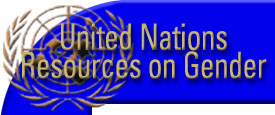

 |
|
 |
|
 |
|
 |
|
 |
|
 |
|
The UN world conferences of the 1990s generated global consensus on the centrality of gender equality and women's rights to achieving other development goals. At the Fourth World Conference on Women in Beijing (1995), 183 governments agreed to the Beijing Platform for Action (PFA), an ambitious set of commitments to achieve women's empowerment and gender equality. Governments of the world are gathering to assess progress and review obstacles to implementation of the PFA in a General Assembly Special Session: Women2000 - Equality, Development and Peace in the 21st Century (5 - 9 June 2000, UN Headquarters, New York).
In 1997 and 1998, as a follow-up to several initiatives to support integrated and coordinated follow-up to UN World Conferences by UN organizations, a number of recommendations and requests for good practices emerged; notably, the report of the 1997 Inter-Agency Workshop on Field Level Follow-up to Global Conferences, and the reports of the 1996 and 1997 sessions of the Commission on the Status of Women. Accordingly, this collection is the result of a special task force mandated by the Interagency Committee on Women and Gender Equality (IACWGE), which has representation from the majority of UN organizations and departments. The IACWGE Good Practices Task Force, coordinated by UNIFEM and with the participation of UNDP, UNFPA, UNICEF, and HABITAT, guided the development of criteria for good practices, the scope of the collection, and the development of this database. This collection of good practices has been created as a resource for organizations that are committed to implementing programmes to support gender equality and are interested in learning from the experiences of others. It has been developed to:
In the first phase of the project to create a UN system good practices database, the collection has been limited to projects supported by United Nations organizations. The initiatives of more than 20 UN organizations are currently represented in this collection, which is expected to grow to encompass many more. In later phases, it may be possible to have good practices from a much broader range of contributors, including women's networks, NGOs, government and donors. |